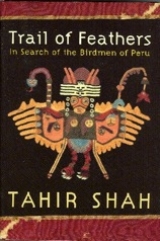
Trail of Feathers
Encyclopedia
Trail of Feathers is a travel book by Anglo-Afghan author, Tahir Shah
.
Enthralled by a line from the chronicle of a sixteenth-century monk, which said that the Incas ‘flew like birds’ over the jungle, and by the recurring theme of flying in Peru
vian folklore, Tahir Shah set out to discover whether the Incas really did fly or glide above the jungles of Peru. Or was the Spanish cleric alluding to flight of a different kind – flight inspired by a powerful hallucinogen?
After gathering equipment in London – and advice from Wilfred Thesiger
– the long quest begins.
First, to the mountains of Peru and a trek to Machu Picchu
, the Incas’ most sacred city. Then on to the mountain city of Cusco
and a mysterious island on the great glittering expanse of Lake Titicaca. Picking up clues as he goes, Shah's trail takes him on to the coast and through the desert, to the immense animal-like etchings which form the Nazca Lines
, and a remote burial ground for 30,000 mummified corpses. And finally to an extended river journey up the Amazon to discover the secrets of the Shuar
, a tribe of infamous savagery living in the deep jungle of the Upper Amazon.
In the course of this journey we learn much about the Spanish treatment of the Incas, about Peruvian folklore and magic, about the great but brief Amazon rubber boom
of the nineteenth century, about head-shrinking
, shamanic knowledge and plant-based hallucinogens.
Even for a traveller so used to surreal adventures, there are many strange encounters and physical challenges – gruesome but sometimes humorous – among madmen and dreamers, sorcerers, con-men and jungle experts, before Tahir Shah can at last discover the truth about the Birdmen of Peru.
Tahir Shah
Tahir Shah , né Sayyid Tahir al-Hashimi is an Anglo-Afghan Indian author, journalist and documentary maker. He lives in Casablanca, Morocco.-Family origins and life:...
.
Enthralled by a line from the chronicle of a sixteenth-century monk, which said that the Incas ‘flew like birds’ over the jungle, and by the recurring theme of flying in Peru
Peru
Peru , officially the Republic of Peru , is a country in western South America. It is bordered on the north by Ecuador and Colombia, on the east by Brazil, on the southeast by Bolivia, on the south by Chile, and on the west by the Pacific Ocean....
vian folklore, Tahir Shah set out to discover whether the Incas really did fly or glide above the jungles of Peru. Or was the Spanish cleric alluding to flight of a different kind – flight inspired by a powerful hallucinogen?
After gathering equipment in London – and advice from Wilfred Thesiger
Wilfred Thesiger
Sir Wilfred Patrick Thesiger, CBE, DSO, FRAS, FRGS was a British explorer and travel writer born in Addis Ababa, the capital of Ethiopia.-Family:...
– the long quest begins.
First, to the mountains of Peru and a trek to Machu Picchu
Machu Picchu
Machu Picchu is a pre-Columbian 15th-century Inca site located above sea level. It is situated on a mountain ridge above the Urubamba Valley in Peru, which is northwest of Cusco and through which the Urubamba River flows. Most archaeologists believe that Machu Picchu was built as an estate for...
, the Incas’ most sacred city. Then on to the mountain city of Cusco
Cusco
Cusco , often spelled Cuzco , is a city in southeastern Peru, near the Urubamba Valley of the Andes mountain range. It is the capital of the Cusco Region as well as the Cuzco Province. In 2007, the city had a population of 358,935 which was triple the figure of 20 years ago...
and a mysterious island on the great glittering expanse of Lake Titicaca. Picking up clues as he goes, Shah's trail takes him on to the coast and through the desert, to the immense animal-like etchings which form the Nazca Lines
Nazca Lines
The Nazca Lines are a series of ancient geoglyphs located in the Nazca Desert in southern Peru. They were designated a UNESCO World Heritage Site in 1994. The high, arid plateau stretches more than between the towns of Nazca and Palpa on the Pampas de Jumana about 400 km south of Lima...
, and a remote burial ground for 30,000 mummified corpses. And finally to an extended river journey up the Amazon to discover the secrets of the Shuar
Shuar
The Shuar people are an indigenous people of Ecuador and Peru. They are members of the Jivaroan peoples, who are Amazonian tribes living at the headwaters of the Marañón River.-Name:...
, a tribe of infamous savagery living in the deep jungle of the Upper Amazon.
In the course of this journey we learn much about the Spanish treatment of the Incas, about Peruvian folklore and magic, about the great but brief Amazon rubber boom
Rubber boom
The rubber boom was an important part of the economic and social history of Brazil and Amazonian regions of neighboring countries, being related with the extraction and commercialization of rubber...
of the nineteenth century, about head-shrinking
Shrunken head
A shrunken head is a severed and specially prepared human head that is used for trophy, ritual, or trade purposes.Headhunting occurred in many regions of the world. But the practice of headshrinking has only ever been recorded in the northwestern region of the Amazon rain forest...
, shamanic knowledge and plant-based hallucinogens.
Even for a traveller so used to surreal adventures, there are many strange encounters and physical challenges – gruesome but sometimes humorous – among madmen and dreamers, sorcerers, con-men and jungle experts, before Tahir Shah can at last discover the truth about the Birdmen of Peru.

